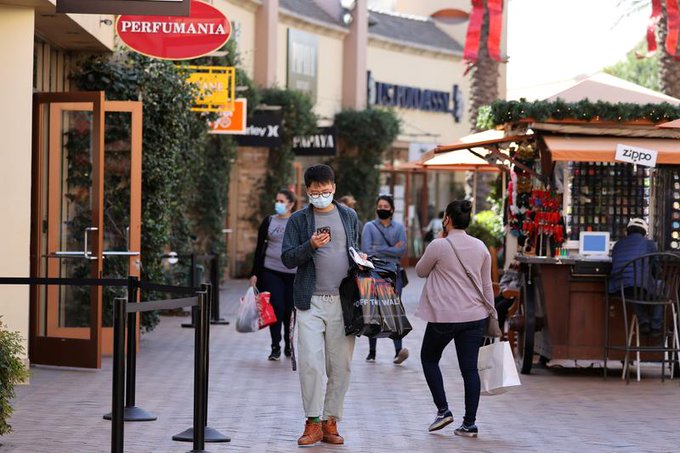FILE PHOTO: People shop at the Citadel Outlet mall, as the global outbreak of the coronavirus disease (COVID-19) continues, in Commerce, California, U.S., December 3, 2020. REUTERS/Lucy Nicholson/File Photo
By Lucia Mutikani
Source: www.reuters.com, December 2020
WASHINGTON (Reuters) – U.S. retail sales fell more than expected in November, likely weighed down by raging new COVID-19 infections and decreasing household income, adding to growing signs of a slowdown in the economy’s recovery from the pandemic recession.
The second straight monthly decline in retail sales reported by the Commerce Department on Wednesday could nudge Congress to agree on another fiscal stimulus package. Still, economists say more money from the government and the rollout of coronavirus vaccines would probably not stop the economy from sharply slowing down and even contracting in the first quarter of 2021.
The Federal Reserve kept its benchmark overnight interest rate near zero and pledged to continue pumping money into the economy to fight the recession.
“The economy is hitting a very rough patch,” said Gus Faucher, chief economist at PNC Financial in Pittsburgh, Pennsylvania. “Although widespread vaccine distribution will support stronger economic growth by mid-2021, conditions will remain soft until then.”
Retail sales dropped 1.1% last month, with receipts declining almost across the board. Data for October was revised down to show sales slipping 0.1% instead of rising 0.3% as previously reported, adding a sting to the report.
It was the first back-to-back decline in sales since April, when stringent measures to control the first wave of coronavirus cases crippled the economy, and marked a weak start to the holiday shopping season. Economists polled by Reuters had forecast retail sales would decrease 0.3% in November. Sales increased 4.1% on a year-on-year basis.
The plunge in sales last month was led by motor vehicles, with receipts at auto dealerships tumbling 1.7% after being unchanged in October. Receipts at clothing stores plummeted 6.8%. Consumers also cut back on eating and drinking out. Sales at restaurants and bars dropped 4.0%.
Sales at electronics and appliance stores fell 3.5% and receipts at furniture stores declined 1.1%. There were also decreases in sales at sporting goods, hobby, musical instrument and book stores. But receipts at food and beverage stores rose, as did those at building material stores.
Online retail sales rose a modest 0.2%. Some economists said Amazon.com’s “Prime Day” event in October had pulled sales from November. Online retail sales soared 2.4% in October.
“With COVID cases still near peak levels and state and local governments adding further mandates in recent weeks, we expect more weakness from retail sales ahead,” said Ben Ayers, senior economist at Nationwide in Columbus, Ohio.
Stocks on Wall Street were mixed. The dollar was steady against a basket of currencies. U.S. Treasury prices fell.
GRAPHIC: Retail sales –
RECOVERY SLOWING
Excluding automobiles, gasoline, building materials and food services, retail sales declined 0.5% last month after a downwardly revised 0.1% fall in October. These so-called core retail sales correspond most closely with the consumer spending component of gross domestic product. They were previously estimated to have edged up 0.1% in October.
The United States is struggling with a fresh COVID-19 outbreak, with the death toll from the disease rising above the 300,000 mark on Monday, according to a Reuters tally of official data. Many state and local governments have imposed new restrictions on businesses, while some consumers are avoiding shopping malls, restaurants and bars.
Restaurants moved outdoors over the summer and the arrival of cold weather is also undercutting spending. A separate report from data firm IHS Markit on Wednesday showed business activity slowed in the first half of December.
GRAPHIC: Markit –
The reports added to data this month showing the economy, which plunged into recession in February, added the fewest jobs in six months in November. The number of people filing new claims for unemployment benefits jumped to a near three-month high in the first week of December.
The situation has been compounded by the loss of a weekly unemployment supplement. More than $3 trillion in government coronavirus relief is almost depleted, and at least 9 million unemployed and underemployed Americans are set to lose government-funded benefits on Dec. 26.
Lawmakers neared a $900 billion deal for another rescue package on Wednesday. But economists said this was insufficient given the shock caused by the pandemic.
“They are trying to get a modest relief package done to help those in need rather than a trillion-dollar mega-package like in March that turned the recession around quickly with a recovery that was V-shaped for a time,” said Chris Rupkey, chief economist at MUFG in New York. “The outlook now for the economy is grim despite the miracle vaccines that are on the way.”
Health experts have cautioned it could take a while for many Americans to be inoculated. Growth estimates for the fourth quarter are mostly below a 5% annualized rate.
Most economists expect the economy to contract in the first three months of 2021.
The economy grew at a 33.1% rate in the third quarter after contracting at a 31.4% pace in the April-June quarter, the deepest since the government started keeping records in 1947.
Reporting by Lucia Mutikani; Editing by Paul Simao and Andrea Ricci



